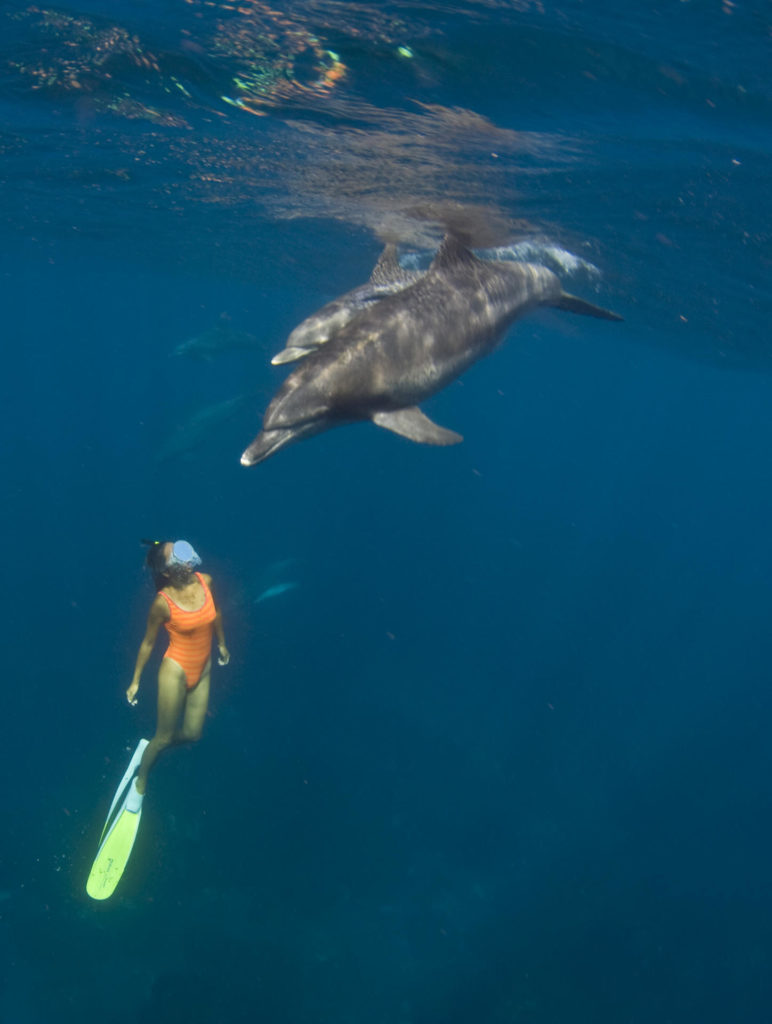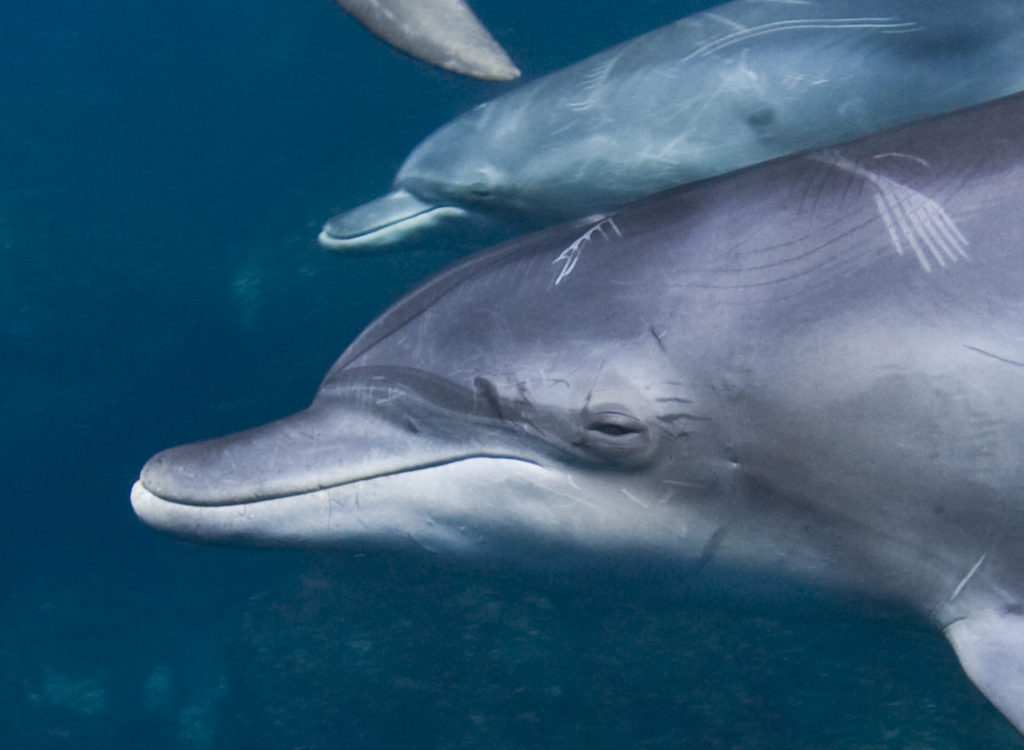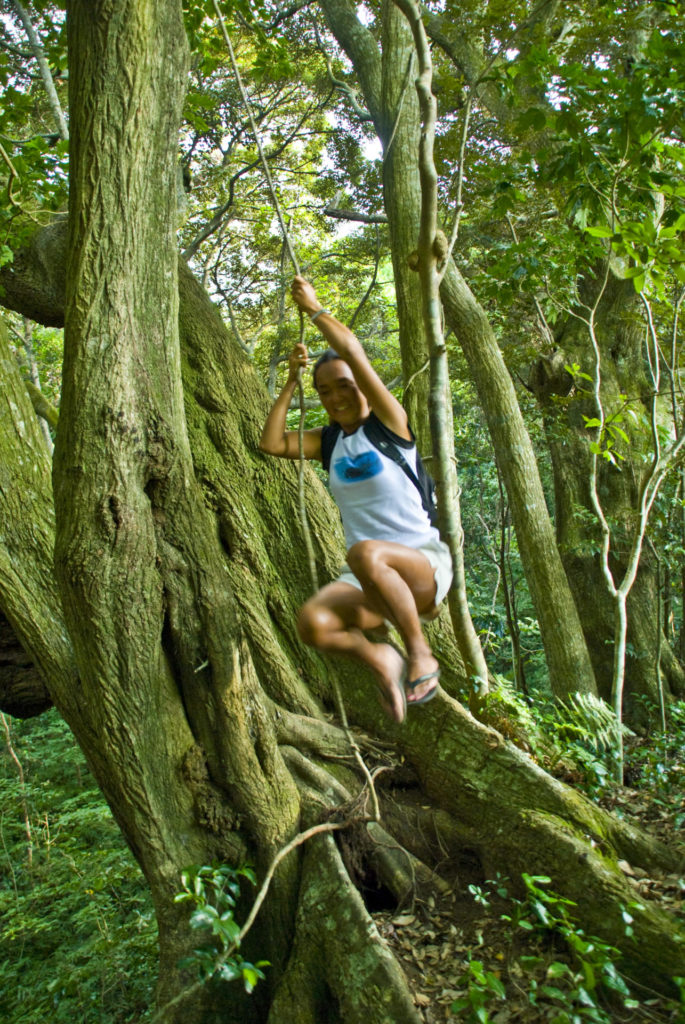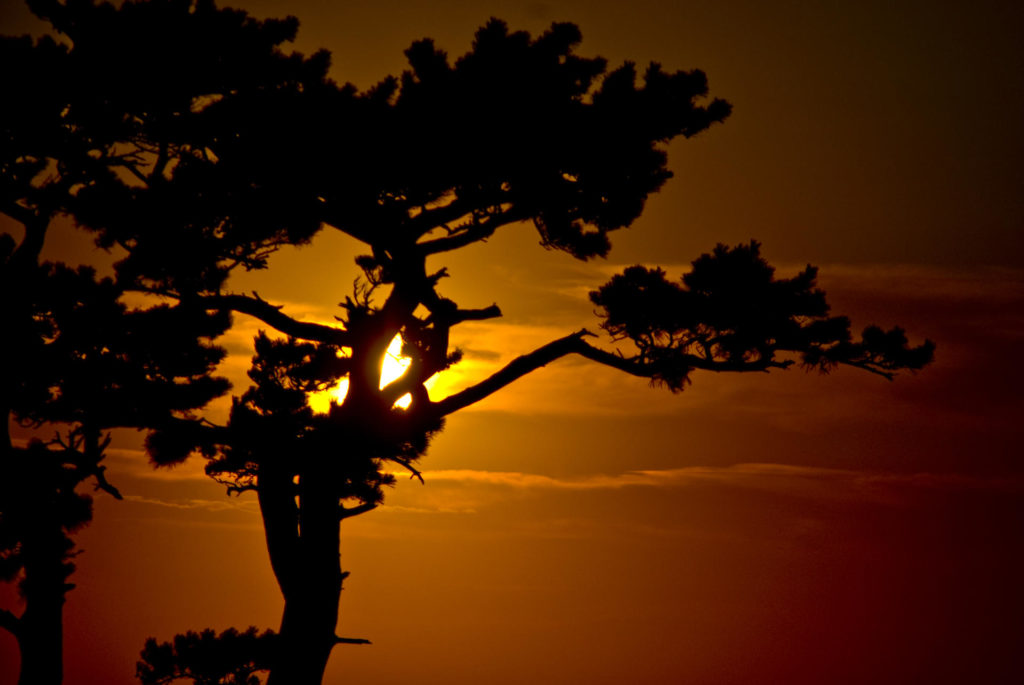
There are no beaches here, at least not sandy ones. No seaside inns. The terrain is best described as vertical, making one wonder how the first people even landed here. Rugged as they come yet beautifully forested, Mikura-jima is a small, yet spectacular, piece of Tokyo real estate known for deep forest, huge trees and dolphins.
Mikura-jima (Mikura Island) pokes up high above the sea in the Izu Island chain. It was once a major wood supplier, yet today it is best known for its thick, unharvested wooded slopes and clear, cool waters that are home to an approachable population of bottlenose dolphins. Weekenders make the overnight cruise from Tokyo’s Takeshiba Port to try spending some quality time with the 160+ resident dolphins that circle the island’s rich waters.
The ferry to Mikura-jima makes three stops. The first, as the sun is just peeking over the horizon, is at Miyake-jima. A volcanic explosion ravaged this island in 2000, and you can see the lava field that ran down to the edge of town. For many years, the residents were relocated but they are now back on their island hosting tourists who come to the black sand beaches.

The next stop is Mikura, a volcanic cone of years gone by, protruding from the sea; it’s always a gamble if it is calm enough for the ship to dock. A huge man-made pier and marina provide shelter for local boats. A steep road heads straight up to the tiny town.
Fewer than 300 people call the island home. Houses are built into the hillsides, and seemingly everyone has a great view of the sea. From here, the ship continues on to Hachijo-jima. Dolphin lovers come to Mikura to see the large group of bottlenose dolphins. This place is rich in sea life, and the dolphins thrive here, finding an abundance of food in the deep waters just off the island, while the steep cliffs offer shelter from inclement weather. As our ship arrives, countless sea birds steal fish from the water.
An ocean current, oddly called the “black current” (kuroshio), usually passes by Mikura, bringing lovely warm water with it. When it reaches Mikura, the water temperature rises to 23C even in May. If not, it’s a rather robust 17-18 degrees which can take your breath away when you first hit the water and can be cold even if you’re snorkeling like crazy to keep up with the dolphins. With the current, the water can reach a tropical 30 degrees in July and August, which explains why it’s the most popular time to see dolphins.
For whatever reason, the current recently has been flowing by about 100 miles away from Mikura. This anomaly occurs every few decades, so the water temperature around Mikura was chilly when we visited. Visibility wasn’t bad, but we were told it is superb with the kuroshio. I wondered if I would at least have any luck with flat seas, which brought a few smiles. “There are no calm seas around Mikura. That’s Mikura,” laughs Mio Yanagase of the Dolphin Communication Project, who I met through some mutual dolphin-loving friends. Luckily, you can always hide in the lee of the island and look for dolphins. There it is nice enough for snorkeling, and the dolphins eventually come around. Mio told me they have named many of these dolphins. On our first trip out, my snorkeling buddy, Yoko, saw one with only half of a tail. “That must be Hata-boh,” Mio points out. She says they all have distinguishable markings and sometimes remarkable personalities. “Koshakure always cuts into the photos,” she said of one of her favorite mugging dolphins.
Scuba diving isn’t allowed here to make sure the dolphins’ habitat and habits aren’t disturbed. They are important to the economy as fishing has giving way to eco-tourism. Observers know them by name, varying from descriptive, while others are fun. Sting, Gang, Sekapun, Y-chan, Dokkiri Joo, Kitte, Ringo-chan and the list goes on.
We were impressed with the size of the dolphins which appear to be well fed. The ones we saw on our first excursion were on a mission and didn’t stop to play. They did slow to look at us, and we got to see a mother and baby and swim with them. They seemed to like swimming in groups of three. We dropped in several times as we followed the pod for a good morning of interaction.
The seas kicked up, and getting back to the marina was an adventure in itself. I was thankful for the steady hand of the captain as we negotiated some rather awe-inspiring swells that made us feel quite small.
People don’t just come for the dolphins. This is one of the most wooded pieces of real estate in Japan. There is healthy hike to a lake in the remnants of the volcanic cone high atop the island. Waterfalls flow directly from the forest down the cliffs and into the sea. These can be reached by boat, and one can snorkel to the rocky beach to experience the pounding of the cold, fresh water.

There are hikes great and small here. One of which starts right in town and yields a rare sight, the biggest tree in Mikura, and in fact Japan, measuring more than 13 meters in circumference. The path begins with some steps that run through a bamboo valley and up into a cool vale. The wind makes the bamboo and tree limbs clack and creek. Leaves flutter to the ground.
It’s not a long hike, about one kilometer each way, to the big trees, but the flora is diverse. In true Mikura fashion, the trail goes uphill and downhill, with a few flat stretches, but it is mostly up.
We hiked past the featured tree, which is huge, but there are others almost as big, and it was fun to venture beyond. A few forks and a few stream crossings lead way up into woods where the trail is faint but evident. Long vines grew from some of these monsters and were strong enough to support my 91 swinging kilos.
According to one of the DCP volunteers, the definition of a big tree in Japan is one that is three meters or larger in circumference. That would make hundreds, if not thousands, of “big trees” on this island, so the definition here is modified to five meters or larger, which yields 600 trees here on tiny Mikura alone.
The hike can be done at a leisurely pace, and it was dusk before we made it down. When we wandered into town, the sun was painting the sky. The silhouettes of banzai-looking bonsai? trees filled the horizon as night set over the village. It was time for a meal, a hot bath overlooking the lights of town and a long, cozy sleep.
The next morning we set out again in search of dolphins. We encountered a big group frolicking in the shallow waters near the Shirataki waterfall. There were adult males chasing young females, juveniles playing in the waves, and mothers with young calves. The sea floor below was a flowing carpet of beautiful red and green seaweed. Kitte, Ringo-chan and others we recognized were part of our morning company.
We were slated to leave on the afternoon ship, so decided to explore one finger of the village we had ignored. There was an interesting, and obviously very old, Shinto Shrine. The steps to this shrine can be seen from the road, as there is a monument below marked by a ship’s huge anchor.
The shrine probably dates back to the island’s first permanent residents. You can eat here at one of the many small restaurants, learn to carve a dolphin or just walk down to the lookout and look out to sea for a sign of dolphins. We went down to the shoreline and marveled at the rocky beach comprised of thousands of rolling round volcanic rocks. An old sea wall showed some wear as it had been tested by Mother Ocean’s powerful waves. The ship was able to dock, and we left Mikura full of memories of marine mammals and mighty forest trees. This combination of “surf and turf” makes Mikura a magical eco-destination.

Mikura Practicalities
Getting There: Tokai Kisen has daily ships from Tokyo’s Takeshiba Port that leave in the evening and arrive about eight hours later. There are various levels (and prices) of accommodation onboard. Tokai Kisen: www.tokaikisen.co.jp
Getting Around: On island, most folks walk or join tours to see the sights. Roads are extremely steep in places and narrow with hairpin turns. A local tour driver who knows the roads is a wise investment. Dolphin tours can be arranged through your accommodation or directly through tour companies.
Communications & Money: ATM cash is available at the post office. Cash is preferred although some small hotels accept major credit cards. Phone and Internet are available.
Accommodations: There are small hotels, minshuku and pensions here. In summer, reservations are highly recommended, especially on weekends.




